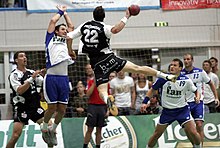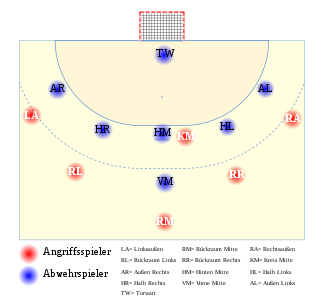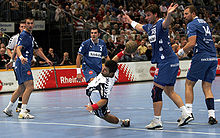Backcourt player





A backcourt player (in Austria and Switzerland also called structure ) is a playing position or a player in handball . In a handball game, a full attacking team usually has three backcourt players: one player each in the positions backcourt left (RL), backcourt middle (RM) and backcourt right (RR). The designation of the playing positions results from the perspective of the own goalkeeper and the normal area of the players in front of the 9-meter line, the so-called back area.
Duties of the backcourt players
While the tasks of the two outer backcourt positions are the same, the player in the middle backcourt position has a significantly different function.
Back center
The player in the center backcourt position is often called the playmaker . Its task is, among other things , to announce or initiate game moves, i.e. game sequences that have been rehearsed in training, for example with crosses, bans, running in or even Kempa tricks . The moves often have numbers that are called or displayed with the fingers. Sometimes the moves also have code names or it can be a specific, previously agreed gesture. For example, Markus Baur , the playmaker of the German national team , with a grip on his nose, announced a spectacular Kempa trick in the semi-final match Germany - France at the 2007 World Cup , which Dominik Klein turned into a 23:23 equalizer.
In contrast to his two teammates in the left and right backcourt, goals from the backcourt, that is, in the area of the 9-meter line, are rather rare for many playmakers. The distribution of the balls, passes to the circle and breaking into gaps in cover on the circle, that is usually the game in this position. While in men's handball in particular the outer backcourt positions are mostly occupied by very tall players, the position in the middle backcourt - even at the highest international level - can also be filled very well by "normally grown" players. Examples are Talant Dujshebaev with a body length of 1.80 m or even Ljubomir Vranjes with a body length of 1.68 m.
The tasks in cover can be very different. Usually one of the two half-positions is filled. Smaller players, on the other hand, tend to be used in the outer positions. Playmakers with weaker coverage, such as Ivano Balić , are often replaced in defense.
Back space left and back space right
The two backcourt positions in performance handball are usually occupied by very tall players who have a high throwing power. In order to be successful with throws from the back area, a correspondingly high throwing position is required in many cases in order to be able to throw over the opposing defensive block. In some cases, however, this can also be compensated for by an exceptional throwing power. In addition to the throws from the second row, an attempt is often made from this position to push into corresponding gaps in cover in order to get to the goal throw from a significantly shorter distance. There is a risk of an offensive foul , also known as a striker foul .
In addition to these tasks, which are limited to throwing goals (the shooter positions), the two outer backcourt players also play the circle, or their respective outside players, so that goals can be scored using these positions. As a rule, an attempt is made to bind two opponents as far as possible through an action - often only faked - in order to then pass on to the free teammate.
In the cover, the tall back players usually form the so-called center block. Weaker defensive players, such as Pascal Hens , then usually go to the outer positions or are substituted.
There is a slight difference between the two playing positions. Right-handers play on the left back space - this playing position is often referred to in the press as the “king's position” - while left-handers are generally used in all top teams on the right back space. In this position, guiding the ball with the left hand offers the advantage of a more favorable throwing angle to the goal.
Remarks
The hit rates of backcourt players are significantly lower compared to the outside players or the circle striker. The greater distance to the goal - 9 m from the back area compared to 6 m in the other playing positions - gives the opposing goalkeeper more reaction time. In addition, the cover also has the option of blocking a throw.
Known backcourt players
Back center
- Ivano Balić
- Daniel Narcisse
- Markus Baur
- Talant Dujshebaev
- Anita Görbicz
- Gro Hammerseng-Edin
- Michael Kraus
- Stefan Lövgren
- Magnus Wislander
- Iker Romero
- Grzegorz Tkaczyk
- Martin Strobel
- Aron Pálmarsson
- Domagoj Duvnjak
- Andy Schmid
- Michael Haass
- Viktor Szilágyi
- Thomas Mogensen
- Nikola Bilyk
- Petar Nenadic
- Máté Lékai
Back left
- Karol Bielecki
- Joachim Deckarm
- Filip Jícha
- Pascal Hens
- Daniel Stephan
- Nikola Karabatić
- Lars Kaufmann
- Nadine Krause
- Blaženko Lacković
- Momir Ilić
- Siarhei Rutenka
- Erhard Wunderlich
- Jérôme Fernandez
- William Accambray
- Mikkel Hansen
- Klemen Cehte
- Roland Schlinger
- Nikola Bilyk
- Alexander Hermann
- Philipp Weber
- Paul Drux
- Bernd Friede
Back right
- Kim Andersson
- Holger Glandorf
- Grit Jurack
- Jerzy Klempel
- Mariusz Jurasik
- Yoon Kyung-shin
- Kiril Lazarov
- Ólafur Stefánsson
- Christian Zeitz
- Volker Zerbe
- Michael Mueller
- Marcin Lijewski
- Krzysztof Lijewski
- Oscar Carlén
- Steffen Weinhold
- Maximilian Hermann
- Marko Vujin
- Zsolt Balogh
Individual evidence
- ^ Bernhard Kempa - The Fritz Walter of German handball Frankfurter Allgemeine Zeitung November 19, 2010
- ↑ faz.net, reaching for the medal , in Frankfurter Allgemeine Zeitung , December 14, 2007
literature
- Finger N, Tactical Attack Measures in Handball , Johann Wolfgang Goethe University Frankfurt, 2001

